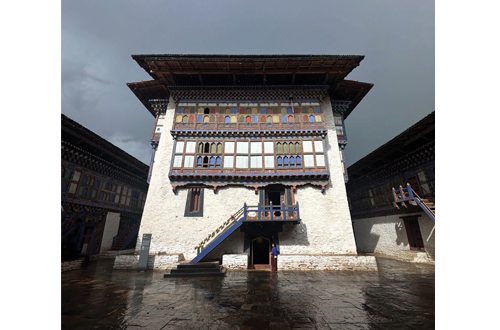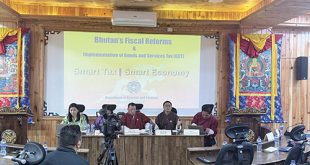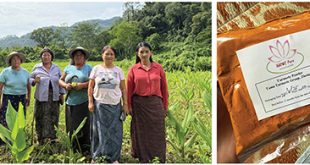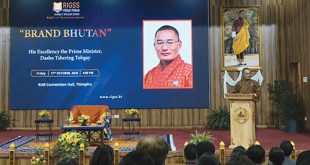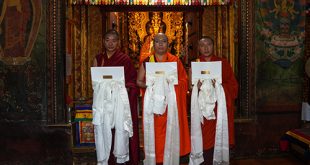By Thukten Tenzin
As I walked through the main entrance of the Wangduechhoeling Palace, a wave of awe and reverence stopped me on my tracks. Stepping into the heart of the Monarchy’s history, every brick and stone seemed to whisper tales of our forefathers’ strength, vision, and resilience. I was about to meet the curator, and eagerly awaited the stories that were about to unfold.
We found the curator a few minutes later. The man is on the shorter side, but he is as sharp as a tack and as wise as a sage. He greeted us with a humble warmth, and a smile crinkled the corners of his eyes as he began to weave the tale of Wangduechhoeling Palace. It is not only a royal abode, the palace serves as a testament to Bhutan’s cultural unity, social identity, and spiritual continuity.
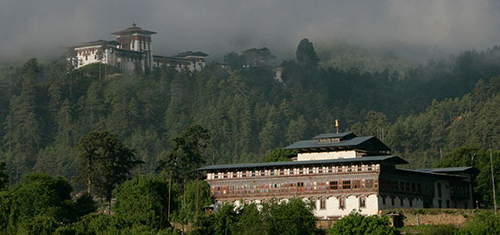
Wangduechhoeling Palace with the Jakar Dzong in the background (Photo Courtesy: Bhutan Life Exposure Tour and Trek)
Wangduechhoeling Palace was built in 1857 by the most illustrious Trongsa Penlop Jigme Namgyel and is the founding seat of the Monarchy in Bhutan. It represents the beginning of the modern history of Bhutan. This Palace is located beside the Chamkhar River and the paddy fields of Jakar Valley, a fertile valley in the central part of Bhutan, and continues to stand as one of Bhutan’s cherished national monuments.
As a history teacher for more than a decade, I have taught my students about Desi Jigme Namgyel who is a national hero in all of its theoretical context. However, my physical visit to the site, along with the museum tour and interaction with the curator, opened my eyes and deepened my interest in our heritage.
Trongsa Poenlop Jigme Namgyel rose from a teenage warrior to become one of the most powerful provincial governor, military commander, and ruler in Bhutan’s history. He outsmarted and outgunned the British forces, and took on some of his powerful feudal rivals in a series of strategic military manoeuvres and territorial conquests. Jigme Namgyel built Wangduechhoeling Palace at the site of one of his victories. The name Wangduechhoeling is itself a token of victory with Wangdue meaning “victory” and chhoeling “a place rich in Buddhism”.
The curator’s animated storytelling gave us a fresh glimpse into the life and times of the palace, revealing fascinating details that transcended the passage of time and the weight of history. The victory of a particular battle in 1857 brought Jigme Namgyel to the status of the secular head of Bhutan. This win ended two decades of internal conflicts and established a political atmosphere that would lead to the emergence of the Wangchuck Dynasty. It is where his son, Gongsar Ugyen Wangchuck, who would go on to become Bhutan’s first hereditary Monarch, was born.
The palace continued to serve as the royal seat until the capital shifted to Paro in 1950 and later to Thimphu. The architectural style of Wangduechhoeling Palace represents the nineteenth-century traditional Bhutanese architecture, with its white stone exterior and interior walls, wattle and daub dividing partitions, and masterfully carved timber lintels and windows. It is home to a number of valuable murals, religious texts, sculptures, artifacts, and textiles. The palace was extensively restored and has been returned to its original glory.
The curator’s elaborative explanation of the palace brought to my ears and eyes many rare historical anecdotes of the era. One of the most interesting and memorable historic events in the royal palace history was the Wangduechhoeling Fair of 1937.
The Wangduechhoeling Fair was organized during the reign of His Majesty the Second King, Druk Gyalpo Jigme Wangchuck, who was known for his warmth, popularity, and sociable nature. He envisioned a grand fair in the heart of central Bhutan to mirror the significance of the Punakha Dromchoes, Bhutan’s most important socio-religious festival celebrated widely in the western region. Preparations for the event took about 19 days, and the weeklong fair became one of the first large scale social festivals in the country.
The event included traditional archery matches, keshay (traditional wrestling), horse races, water fights, food exhibitions, etc. At the time, Bhutan also saw its first screening of movies for the general public, using a projector, as part of the fair. These practices are the early foundations of some of the age-old cultural activities that Bhutanese people enjoy till today.
As I kept listening to the curator about historic narratives at the Palace, I found one story intriguing and wonderful. This great cultural hallmark of the Wangduechhoeling fair was the introduction of sweet tea (Ngaja) in Bhutan by His Majesty the Second King. The King had sent his attendant, Changap Dramitsep, to India to learn how to prepare this sweetened milk tea. It was the first time that many Bhutanese tasted sweet sugar tea at the fair. Since then, Bhutanese have made milk tea an important part of their lives, and enjoy it to this day. The people continued to enjoy these successful annual events for many years in this very historic palace.
Stepping out of the palace, I left with a renewed sense of the complex layers of history and tradition that define this nation. The Wangduechhoeling Palace is more than a relic of the past; it’s a living testament to Bhutan’s journey, its resilience, and the unity of its people. From the bold vision of Trongsa Poenlop Jigme Namgyel to the enduring cultural practices that shape the Wangduechhoeling Fair, the palace tells a story of a nation that is rooted in tradition and open to change. As I walked away, I understood that preserving and passing down the palace’s stories is not just an act of remembrance, but a source of strength and inspiration for future generations, reminding us all of the unique tapestry that is Bhutan.
The writer is a former History teacher
 The Bhutanese Leading the way.
The Bhutanese Leading the way.
